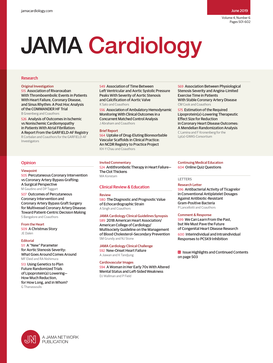Cumulative Cardiovascular Health Score Through Young Adulthood and Cardiovascular and Kidney Outcomes in Midlife.
IF 14.1
1区 医学
Q1 CARDIAC & CARDIOVASCULAR SYSTEMS
引用次数: 0
Abstract
Importance Positive health outcomes of a high cardiovascular health (CVH) score have been demonstrated largely with single CVH assessments in midlife, whereas the association of cumulative CVH during young adulthood with premature cardiovascular disease (CVD) and particularly kidney outcomes remains unclear. Objective To examine the association of cumulative CVH from 30 to 40 years of age with the risk of CVD and kidney events in midlife. Design, Setting, and Participants This population-based cohort study used Korean National Health Insurance health screening and claims data on adults aged 40 years without prior CVD or chronic kidney disease (CKD). Data were analyzed from May 1, 2024, to April 30, 2025. Exposure Ten-year cumulative CVH score, calculated as the area under the CVH score curve from 30 to 40 years of age (range, 0-100 per visit; cumulative range, 0-1000 points × years), based on the American Heart Association's Life's Essential 8 construct. Main Outcomes and Measures The primary outcomes were CVD events (myocardial infarction, ischemic stroke, heart failure, or cardiovascular death) and kidney events (incident CKD, kidney replacement therapy, or kidney-related death) after 40 years of age among participants. Results Among 241 924 adults (78.1% male [n = 188 871]; all aged 40 years) with 3 or more examination visits (at 30 and 40 years of age and ≥1 visits in between; median number of visits, 8 [IQR, 6-10]), 2748 CVD events and 2085 kidney events occurred over a median follow-up of 9.2 years (IQR, 8.4-10.1). The highest quintile (quintile 5 [Q5]; ≥735 points × years) of cumulative CVH from 30 to 40 years of age was associated with a very low incidence of CVD (0.05% per year; adjusted hazard ratio [HR], 0.27 [95% CI, 0.22-0.32] vs Q1) and kidney events (0.05% per year; adjusted HR, 0.25 [95% CI, 0.21-0.31] vs Q1) in midlife. Each 100-point × year higher cumulative CVH (eg, 10-point higher CVH score × 10 years) was associated with a 34% lower hazard of CVD events and a 35% lower hazard of kidney events. The associations were similar by sex and for event subtypes and remained significant after adjustment for CVH score at 40 years of age or the slope of CVH change. Conclusions and Relevance These findings suggest that a higher cumulative CVH score from 30 to 40 years of age was associated with markedly lower risks of CVD and kidney events in midlife, highlighting the importance of sustained primordial prevention efforts throughout early life.青年期累积心血管健康评分与中年期心血管和肾脏预后
高心血管健康(CVH)评分的积极健康结果已在中年时的单一CVH评估中得到证实,而青年期累积CVH与过早心血管疾病(CVD),特别是肾脏预后的关系尚不清楚。目的探讨30 ~ 40岁累积CVH与中年心血管疾病和肾脏事件风险的关系。设计、环境和参与者:这项基于人群的队列研究使用了韩国国民健康保险健康筛查和索赔数据,这些数据来自40岁、既往无心血管疾病或慢性肾脏疾病(CKD)的成年人。数据分析时间为2024年5月1日至2025年4月30日。10年累积CVH评分,计算为30至40岁CVH评分曲线下的面积(范围,每次访问0-100;累积范围,0-1000分×年),基于美国心脏协会的生命基本8结构。主要结局和测量主要结局是参与者40岁后的CVD事件(心肌梗死、缺血性卒中、心力衰竭或心血管死亡)和肾脏事件(CKD事件、肾脏替代治疗或肾脏相关死亡)。结果241 924名成年人(78.1%为男性[n = 188 871],年龄均为40岁)进行3次及以上的检查(30岁和40岁,两者之间≥1次;中位检查次数为8次[IQR, 6-10]),在中位随访9.2年(IQR, 8.4-10.1)期间发生了2748例心血管疾病事件和2085例肾脏事件。30 - 40岁累积CVH最高的五分位数(五分位数5 [Q5];≥735分×年)与中年心血管疾病(每年0.05%;校正危险比[HR], 0.27 [95% CI, 0.22-0.32] vs Q1)和肾脏事件(每年0.05%;校正危险比,0.25 [95% CI, 0.21-0.31] vs Q1)的发生率非常低相关。累积CVH每增加100分×年(例如CVH评分每增加10分× 10年),CVD事件风险降低34%,肾脏事件风险降低35%。这种关联在性别和事件亚型上相似,并且在调整40岁时CVH评分或CVH变化斜率后仍然显著。结论和相关性这些发现表明,30 - 40岁累积CVH评分越高,中年时心血管疾病和肾脏事件的风险越低,强调了在生命早期持续进行原始预防的重要性。
本文章由计算机程序翻译,如有差异,请以英文原文为准。
求助全文
约1分钟内获得全文
求助全文
来源期刊

JAMA cardiology
Medicine-Cardiology and Cardiovascular Medicine
CiteScore
45.80
自引率
1.70%
发文量
264
期刊介绍:
JAMA Cardiology, an international peer-reviewed journal, serves as the premier publication for clinical investigators, clinicians, and trainees in cardiovascular medicine worldwide. As a member of the JAMA Network, it aligns with a consortium of peer-reviewed general medical and specialty publications.
Published online weekly, every Wednesday, and in 12 print/online issues annually, JAMA Cardiology attracts over 4.3 million annual article views and downloads. Research articles become freely accessible online 12 months post-publication without any author fees. Moreover, the online version is readily accessible to institutions in developing countries through the World Health Organization's HINARI program.
Positioned at the intersection of clinical investigation, actionable clinical science, and clinical practice, JAMA Cardiology prioritizes traditional and evolving cardiovascular medicine, alongside evidence-based health policy. It places particular emphasis on health equity, especially when grounded in original science, as a top editorial priority.
 求助内容:
求助内容: 应助结果提醒方式:
应助结果提醒方式:


